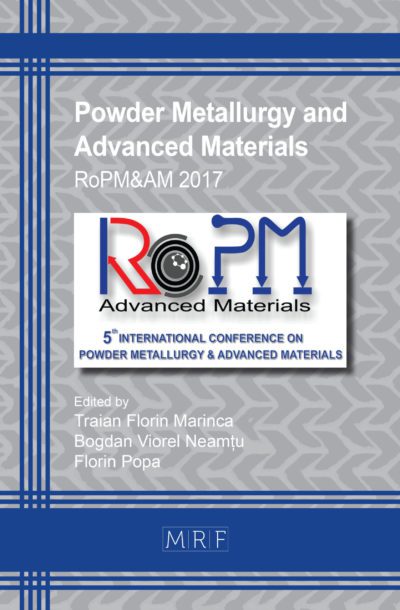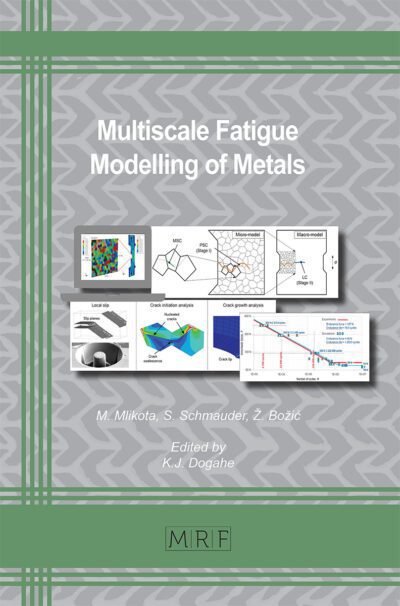Investigation of machining performance of lead-free brass materials forged in different conditions after cooling with liquid nitrogen
ATAY Gokhan, ZOGHIPOUR Nima, KAYNAK Yusuf
download PDFAbstract. The forging process, which is one of the hot forming methods, is used to produce plumbing systems, valves, batteries, fittings, condensers, pipes, etc. from brass alloys in duplex structures. Compared to leaded brasses, machining becomes very difficult due to reasons such as long and continuous chips, burrs, built-up edge in the tool, and unacceptable surface quality problems. In this study, studies have been carried out to improve the machining process that minimizes the mentioned machining problems by controlling the microstructural of lead-free brass materials. Therefore, by examining the effect of the copper content of the forged material, forging temperature, the cryogenic cooling method input parameters after forging on the phase ratio of the material, investigations were carried out on obtaining a high-performance machining process close to the machinability performance of leaded brass materials with good chip breakability. The change in the distribution of beta phases in the material after forging was investigated and machining tests were performed as a hole drilling operation. Cutting forces, surface roughness, and dimensional accuracy analyzes were evaluated within this purpose. The relationship between the beta phase ratio in the material and the machinability has been revealed and it has been observed that the CW511L alloy produced in three different ratios in the standard range and although they are the same material, the Cu% ratio causes significant changes in terms of machinability.
Keywords
Lead-Free Brass, Microstructure, Hot Forging, Machining, Cryogenic Cooling
Published online 4/19/2023, 10 pages
Copyright © 2023 by the author(s)
Published under license by Materials Research Forum LLC., Millersville PA, USA
Citation: ATAY Gokhan, ZOGHIPOUR Nima, KAYNAK Yusuf, Investigation of machining performance of lead-free brass materials forged in different conditions after cooling with liquid nitrogen, Materials Research Proceedings, Vol. 28, pp 1357-1366, 2023
DOI: https://doi.org/10.21741/9781644902479-147
The article was published as article 147 of the book Material Forming
![]() Content from this work may be used under the terms of the Creative Commons Attribution 3.0 license. Any further distribution of this work must maintain attribution to the author(s) and the title of the work, journal citation and DOI.
Content from this work may be used under the terms of the Creative Commons Attribution 3.0 license. Any further distribution of this work must maintain attribution to the author(s) and the title of the work, journal citation and DOI.
References
[1] R. Francis, The corrosion of copper and its alloys: a practical guide for engineers, NACE International, 2010.
[2] X. Chen, A. Hu, M. Li, D. Mao, Study on the properties of Sn–9Zn–xCr lead-free solder, J. Alloy. Compd. 460 (2008) 478-484. https://doi.org/10.1016/j.jallcom.2007.05.087
[3] H. Atsumi, H. Imai, S. Li, K. Kondoh, Y. Kousaka, A. Kojima, High-strength, lead-free machinable α–β duplex phase brass Cu–40Zn–Cr–Fe–Sn–Bi alloys, Mater. Sci. Eng. A 529 (2011) 275-281. http://doi.org/10.1016/j.msea.2011.09.029
[4] TSE, TS EN 12165, in Copper and copper alloys – Wrought and unwrought forging stock, 2016.
[5] A.L. Fontaine, V. Keast, Compositional distributions in classical and lead-free brasses, Mater. Charact. 57 (2006) 424-429.
[6] C. Nobel, F. Klocke, D. Lung, S. Wolf, Machinability enhancement of lead-free brass alloys, Procedia CIRP 14 (2014) 95-100. https://doi.org/10.1016/j.procir.2014.03.018
[7] G.A. Pantazopoulos, A.I. Toulfatzis, Fracture modes and mechanical characteristics of machinable brass rods, Metallogr. Microstruct. Anal. 1 (2012) 106-114. https://doi.org/10.1007/s13632-012-0019-7
[8] A.I. Toulfatzis, G. Pantazopoulos, A. Paipetis, Microstructure and properties of lead-free brasses using post-processing heat treatment cycles, Mater. Sci. Technol. 32 (2016) 1771-1781. https://doi.org/10.1080/02670836.2016.1221493
[9] A.I. Toulfatzis, G. Pantazopoulos, C. David, D.S. Sargis, A. Paipetis, Final heat treatment as a possible solution for the improvement of machinability of pb-free brass alloys, Metals 8 (2018) 575. https://doi.org/10.3390/met8080575
[10] A.I. Toulfatzis, G. Pantazopoulos, A. Paipetis, Fracture mechanics properties and failure mechanisms of environmental-friendly brass alloys under impact, cyclic and monotonic loading conditions, Eng. Fail. Anal. 90 (2018) 497-517. https://doi.org/10.1016/j.engfailanal.2018.04.001
[11] N. Zoghipour, G. Atay, Y. Kaynak, Modeling and optimization of drilling operation of lead-free brass alloys considering various cutting tool geometries and copper content, Procedia CIRP 102 (2021) 246-251. https://doi.org/10.1016/j.procir.2021.09.042
[12] A. Gharibi, Y. Kaynak, The influence of depth of cut on cryogenic machining performance of hardened steel, J. Faculty Eng. Archit. Gazi University 34 (2019) 582-596.
[13] Y. Kaynak, H. Karaca, I. Jawahir, Cutting speed dependent microstructure and transformation behavior of NiTi alloy in dry and cryogenic machining, J. Mater. Eng. Perform. 24 (2015) 452-460. https://doi.org/10.1007/s11665-014-1247-6
[14] Y. Kaynak, H. Karaca, R.D. Noebe, I. Jawahir, Analysis of tool-wear and cutting force components in dry, preheated, and cryogenic machining of NiTi shape memory alloys, Procedia CIRP 8 (2013) 498-503. https://doi.org/10.1016/j.procir.2013.06.140
[15] Y. Kaynak, H. Karaca, R.D. Noebe, I. Jawahir, Tool-wear analysis in cryogenic machining of NiTi shape memory alloys: A comparison of tool-wear performance with dry and MQL machining, Wear 306 (2013) 51-63. https://doi.org/10.1016/j.wear.2013.05.011
[16] O. Pereira, A. Rodríguez, A.I. Fernández-Abia, J. Barreiro, L.N. López de Lacalle, Cryogenic and minimum quantity lubrication for an eco-efficiency turning of AISI 304, J. Clean. Prod. 139 (2016) 440-449. https://doi.org/10.1016/j.jclepro.2016.08.030
[17] L. Collini, Copper Alloys: Early Applications and Current Performance-Enhancing Processes, 2012, BoD–Books on Demand.
[18] A.I. Toulfatzis, G.J. Besseris, G. Pantazopoulos, C. Stergiou, Characterization and comparative machinability investigation of extruded and drawn copper alloys using non-parametric multi-response optimization and orthogonal arrays, Int. J. Adv. Manuf. Technol. 57 (2011) 811-826. https://doi.org/10.1007/s00170-011-3319-1
[19] G. Pantazopoulos, A. Vazdirvanidis, Characterization of the microstructural aspects of machinable-phase brass, Microscopy and Analysis (2008) 13.
[20] J.R. Davis, Copper and copper alloys, ASM international, 2001.
[21] C. Nobel, U. Hofmann, F. Klocke, D. Veselovac, Experimental investigation of chip formation, flow, and breakage in free orthogonal cutting of copper-zinc alloys, Int. J. Adv. Manuf. Technol. 84 (2016) 1127-1140. https://doi.org/10.1007/s00170-015-7749-z
[22] M. Kurt, Y. Kaynak, E. Bagci, H. Demirer, M. Kurt, Dimensional analyses and surface quality of the laser cutting process for engineering plastics, Int. J. Adv. Manuf. Technol. 41 (2009) 259-267. https://doi.org/10.1007/s00170-008-1468-7
[23] S. Vajpayee, Analytical study of surface roughness in turning, Wear 70 (1981) 165-175. https://doi.org/10.1016/0043-1648(81)90151-4

































